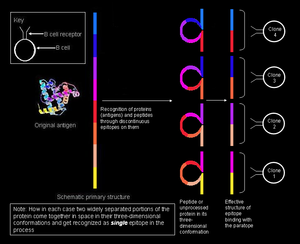
Conformational epitope
Encyclopedia

Antigen
An antigen is a foreign molecule that, when introduced into the body, triggers the production of an antibody by the immune system. The immune system will then kill or neutralize the antigen that is recognized as a foreign and potentially harmful invader. These invaders can be molecules such as...
that come in direct contact with a receptor of the immune system.
An antigen is any substance that the immune system
Immune system
An immune system is a system of biological structures and processes within an organism that protects against disease by identifying and killing pathogens and tumor cells. It detects a wide variety of agents, from viruses to parasitic worms, and needs to distinguish them from the organism's own...
can recognize as foreign. Since, antigens are usually proteins that are too large to bind as a whole to any receptor, only specific segments that form the antigen bind with a specific receptor. Such segments are called epitope
Epitope
An epitope, also known as antigenic determinant, is the part of an antigen that is recognized by the immune system, specifically by antibodies, B cells, or T cells. The part of an antibody that recognizes the epitope is called a paratope...
s. Likewise, it is only paratope
Paratope
The paratope is the part of an antibody which recognises an antigen, the antigen-binding site of an antibody. It is a small region of the antibody's Fv region and contains parts of the antibody's heavy and light chains....
of the receptor that comes in contact with the epitope.
Protein
Protein
Proteins are biochemical compounds consisting of one or more polypeptides typically folded into a globular or fibrous form, facilitating a biological function. A polypeptide is a single linear polymer chain of amino acids bonded together by peptide bonds between the carboxyl and amino groups of...
s are composed of repeating nitrogen
Nitrogen
Nitrogen is a chemical element that has the symbol N, atomic number of 7 and atomic mass 14.00674 u. Elemental nitrogen is a colorless, odorless, tasteless, and mostly inert diatomic gas at standard conditions, constituting 78.08% by volume of Earth's atmosphere...
-containing subunits called amino acid
Amino acid
Amino acids are molecules containing an amine group, a carboxylic acid group and a side-chain that varies between different amino acids. The key elements of an amino acid are carbon, hydrogen, oxygen, and nitrogen...
s that in nature do not exist as straight chains called primary structure
Primary structure
The primary structure of peptides and proteins refers to the linear sequence of its amino acid structural units. The term "primary structure" was first coined by Linderstrøm-Lang in 1951...
, but as folded whorls with complex loops. The latter is known as the tertiary structure
Tertiary structure
In biochemistry and molecular biology, the tertiary structure of a protein or any other macromolecule is its three-dimensional structure, as defined by the atomic coordinates.-Relationship to primary structure:...
of a protein. So, whenever a receptor interacts with an undigested antigen, the surface amino acids that come in contact may not be continuous with each other if the protein is unwound. Such discontinuous amino acids that come together in three dimensional conformation and interact with the receptor's paratope are called conformational epitopes. In contrast, if the antigen is digested, small segments called peptide
Peptide
Peptides are short polymers of amino acid monomers linked by peptide bonds. They are distinguished from proteins on the basis of size, typically containing less than 50 monomer units. The shortest peptides are dipeptides, consisting of two amino acids joined by a single peptide bond...
s are formed, which bind with major histocompatibility complex
Major histocompatibility complex
Major histocompatibility complex is a cell surface molecule encoded by a large gene family in all vertebrates. MHC molecules mediate interactions of leukocytes, also called white blood cells , which are immune cells, with other leukocytes or body cells...
molecules, and then later with T cell receptor
T cell receptor
The T cell receptor or TCR is a molecule found on the surface of T lymphocytes that is responsible for recognizing antigens bound to major histocompatibility complex molecules...
s through amino acids that are continuous in a line. These are known as linear epitope
Linear epitope
A linear or a sequential epitope is an epitope that is recognized by antibodies by its linear sequence of amino acids, or primary structure. In contrast, most antibodies recognize a conformational epitope that has a specific three-dimensional shape and its protein structure.An antigen is any...
s.
See also
- AntigenAntigenAn antigen is a foreign molecule that, when introduced into the body, triggers the production of an antibody by the immune system. The immune system will then kill or neutralize the antigen that is recognized as a foreign and potentially harmful invader. These invaders can be molecules such as...
- Linear epitopeLinear epitopeA linear or a sequential epitope is an epitope that is recognized by antibodies by its linear sequence of amino acids, or primary structure. In contrast, most antibodies recognize a conformational epitope that has a specific three-dimensional shape and its protein structure.An antigen is any...
- Epitope mappingEpitope mappingEpitope mapping is the process of identifying the binding sites, or ‘epitopes’, of antibodies on their target antigens .Identification and characterization of the binding sites of antibodies can aid in the discovery and development of new therapeutics, vaccines, and diagnostics.Epitopes can be...
, finding (on an antigen protein) the epitope(s) for a specific antibody
- EpiSearch, A new method to Predict conformational epitopes using phage display peptide sequences. The method is available online at http://curie.utmb.edu/episearch.html

